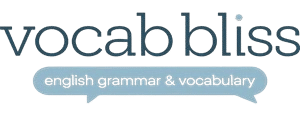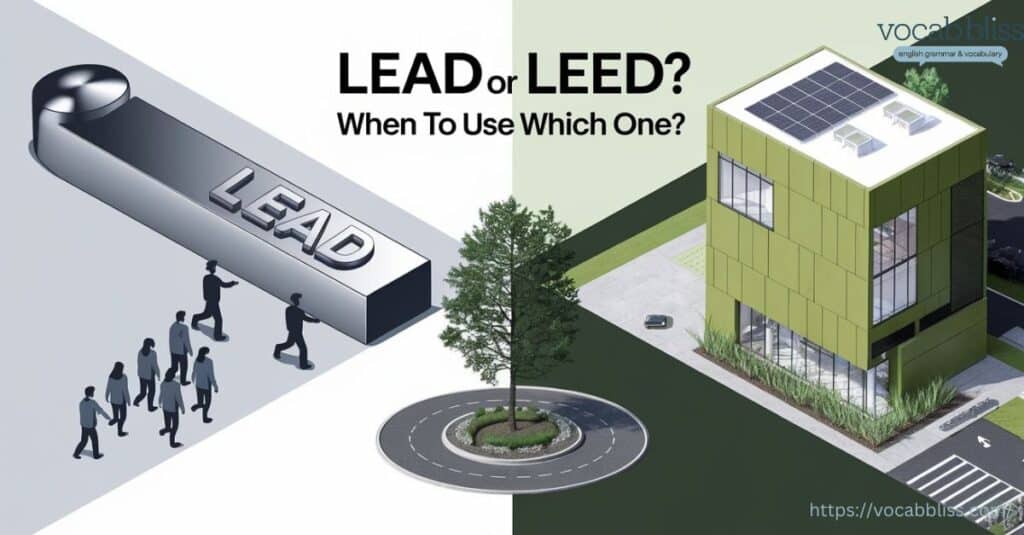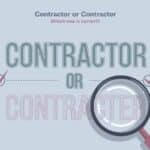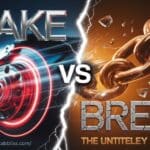Understanding the difference between Lead or LEED can feel like untangling a web of meanings. Whether you’re navigating grammatical nuances or diving into sustainable building certifications, this guide simplifies it for you. Let’s explore each term, its origins, usage, and practical examples to help you use them effectively.
Quick Summary
“Lead or LEED” are two distinct terms with vastly different meanings and applications. Lead, for instance, refers to guiding or influencing as a verb, a position of leadership, a potential business opportunity, or even a heavy, malleable metal. On the other hand, LEED stands for Leadership in Energy and Environmental Design—a globally recognized certification system that promotes sustainable building practices. Therefore, while lead can be applied in various contexts, LEED specifically focuses on environmental sustainability and energy efficiency in construction.. Understanding the difference is crucial: use lead when discussing leadership, guidance, or the metal, and use LEED when referring to environmentally conscious design and construction standards. Both terms play vital roles in their respective contexts, from language and leadership to sustainability and innovation.
Discover more: High Quality or High-Quality: Which One Should You Use?
What Do They Mean?
Lead

Lead is a multifaceted word with several meanings that vary based on context:
- As a verb: It signifies guiding, directing, or influencing. For instance, “She will lead the project to completion.”
- As a noun: It can denote a leadership role, a sales opportunity, or the metal known for its durability and malleability.
- Example: “The company gained a strong lead in the market,” or “Lead is used in industrial applications like batteries and pipes.”
Pronunciation Tip:
- As a verb, “lead” is pronounced like leed (rhymes with “reed”).
- As a noun referring to the metal, it’s pronounced led (rhymes with “red”).
LEED

LEED stands for Leadership in Energy and Environmental Design. Essentially, it serves as a globally recognized certification system that evaluates buildings and projects based on their sustainability and environmental performance. In other words, it helps ensure that buildings are designed to minimize their environmental impact while promoting energy efficiency and resource conservation. Therefore, achieving LEED certification demonstrates a commitment to sustainability and eco-friendly practices. Moreover, LEED encourages eco-friendly practices and promotes energy efficiency in construction and design.
Overview:
- Primary Focus: Reducing environmental impact through eco-friendly building practices.
- Core Areas:
- Energy efficiency
- Sustainable materials
- Water conservation
- Indoor air quality
- Why It Matters: LEED certifications guide architects, planners, and builders to design structures that benefit both people and the planet.
Example: A LEED-certified building might feature solar panels, rainwater harvesting systems, and energy-efficient lighting. As a result, these features contribute to its lower carbon footprint and operational cost savings.
Origins of “Lead or LEED”
Origins of “Lead”
The word lead has a rich linguistic history that reflects its diverse meanings.
- Historical Roots:
- As a verb, “lead” comes from Old English lǣdan, meaning “to guide,” which is linked to the Old Germanic laidjan, or “path.” Consequently, this connection illustrates the term’s long-standing association with leadership and direction.
- As a noun, referring to the act of guiding or being in charge, “lead” retains its roots in concepts of direction and influence. In addition, it signifies authority and the ability to steer others toward a common goal. Thus, it emphasizes leadership and control in various contexts.
- Etymology of Lead as a Metal:
- The metal “lead” traces its origins to the Proto-Indo-European word plowid, thereby signifying its ancient discovery and usage.
- Historically, lead has been a vital resource for human civilization. It has been used for over 6,000 years in applications ranging from Roman plumbing systems to modern batteries and shielding materials. Consequently, its importance has spanned different eras and technological advancements.
Origins of “LEED”
The acronym LEED—short for Leadership in Energy and Environmental Design—has, in fact, a much more modern origin.
- Creation: The U.S. Green Building Council (USGBC) introduced LEED in 1998 to address the growing need for sustainable construction practices.
- Purpose: LEED aims to advance eco-friendly design, energy efficiency, and sustainable construction by setting measurable benchmarks. In addition, it encourages the adoption of green building practices across various industries. As a result, buildings that achieve LEED certification demonstrate a commitment to environmental stewardship.
- Key Milestones:
- Over 100,000 LEED-certified projects across 165+ countries by 2023.
- Expansion of LEED standards to urban planning, retrofitting older structures, and net-zero energy designs.
- Adoption of LEED principles in global initiatives like smart cities and climate-resilient infrastructure.
LEED has become synonymous with sustainability. As a result, it has inspired industries worldwide to prioritize environmental stewardship in their designs and operations.
Lead or LEED: When Should Each Be Used?
Lead
Lead can be applied in several contexts, depending on its function as a verb or noun. Let’s break it down:
As a Verb
When used as a verb, “lead” conveys the act of guiding, initiating, or influencing.
- Example: “She will lead the team in the upcoming project.”
- Application:People frequently use it in contexts such as leadership roles, project management, and mentorship.
As a Noun
- Leadership Position: Refers to being in charge or at the forefront of something.
- Example: “He took the lead in the negotiations.”
- Sales Opportunity: In marketing or sales, a “lead” is a potential customer.
- Example: “The campaign generated 50 new leads.”
- The Metal: Refers to the element lead, widely used in construction, manufacturing, and batteries.
- Example: “Lead is commonly found in car batteries.”

Practical Usage Examples
| Context | Sentence Example |
|---|---|
| Leadership | “They lead the team to victory.” |
| Sales Opportunity | “We have several leads to follow up on.” |
| Metal | “Lead pipes were replaced due to toxicity.” |
LEED
LEED is a certification system designed to advance sustainable practices in building and design.
Certifications in Sustainability and Green Architecture
- Definition: LEED provides a framework for healthy, highly efficient, and cost-saving green buildings.
- Example: “The office complex received a LEED Gold certification for its energy-efficient design.”
As a Benchmark for Eco-Friendly Design
LEED sets industry standards for sustainability, with a strong focus on:
- Minimizing energy consumption.
- Using sustainable, non-toxic materials.
- Reducing water waste.
Examples of Industries Applying LEED Principles
- Architecture: Incorporating green roofs and natural ventilation.
- Real Estate Development: Creating energy-efficient residential complexes.
- Urban Planning: Designing smart cities with green spaces and efficient public transport systems.
Notable Example
| Industry | Example Project | LEED Achievement |
|---|---|---|
| Commercial Real Estate | One Bryant Park, NYC | LEED Platinum |
| Higher Education | Stanford University’s Knight Management Center | LEED Gold |
| Hospitality | Hilton London Bankside | LEED Silver |
Examples in Context lead vs leed
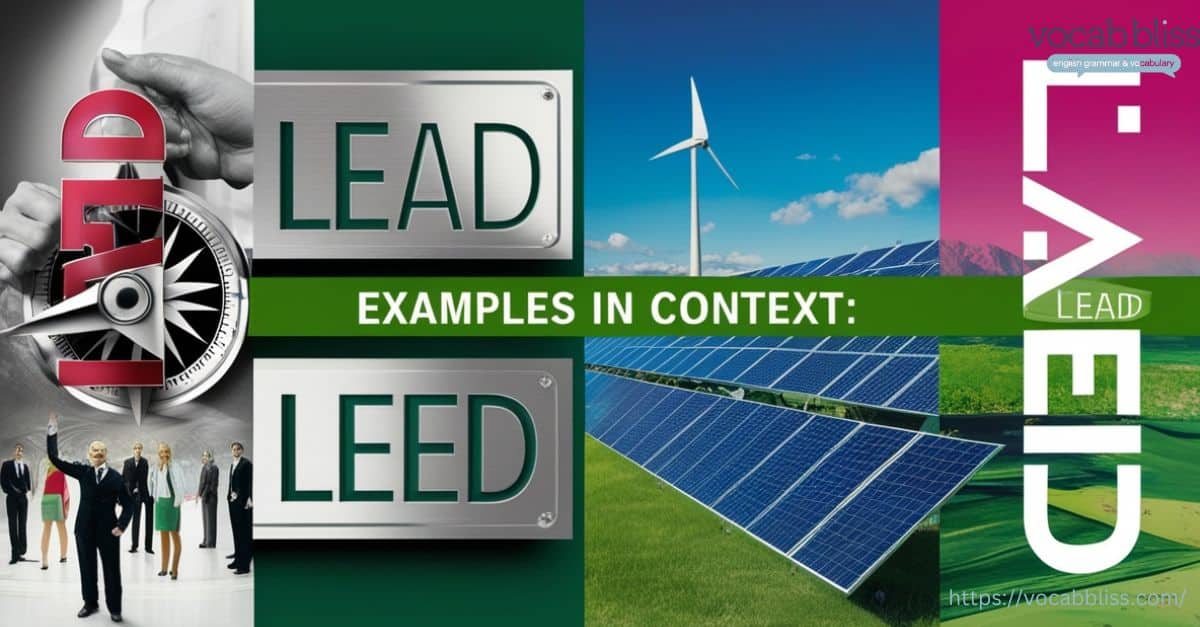
Lead
Lead as a Metal
Lead has been used throughout history for its unique physical and chemical properties.
- Scientific Properties:
- Heavy and dense, with a high atomic number (82).
- Malleable, making it easy to shape and mold.
- Toxic if ingested or inhaled, requiring careful handling.
- Industrial Uses:
- Batteries: A key component in lead-acid batteries for cars and renewable energy storage.
- Construction Materials: Historically used in pipes, roofing, and shielding materials for radiation.
- Weights: Ideal for balancing in machinery, diving equipment, and counterweights.
Example: Lead-acid batteries remain vital for electric grid energy storage due to their reliability and recyclability.
Lead as Leadership
Leadership is another domain where “lead” shines as a concept.
- Examples in Business:
- CEOs and managers often “take the lead” to set strategies and inspire teams.
- In politics, leaders guide nations, communities, or movements.
- Project managers lead their teams to complete projects on time and within budget.
- Motivational Contexts:
- Phrases like “lead by example” emphasize the importance of actions over words.
- “Taking the lead” symbolizes stepping up to challenge norms or obstacles.
Quote: “Leadership is not about being in charge. It’s about taking care of those in your charge.” – Simon Sinek
Lead in Sales Opportunities
In business, a lead represents a potential customer or client who shows interest in a product or service.
For example, a person who requests more information or fills out a contact form may be considered a lead. In addition, leads can vary in quality, with some being highly engaged while others are less responsive.
- Explanation: Leads are vital for driving growth, forming the foundation of sales pipelines.
- Applications:
- CRM Systems: Tools like Salesforce or HubSpot help track and manage leads.
- Lead Generation Strategies: Email campaigns, social media marketing, and content strategies attract and nurture leads.
Example: A lead captured through an online webinar could be nurtured into a loyal customer through personalized follow-ups.
LEED
LEED in Sustainable Building Practices
LEED certification promotes green practices across building projects.
- Practical Examples:
- Installing energy-efficient HVAC systems to reduce energy consumption.
- Using solar panels or wind turbines for renewable energy.
- Incorporating rainwater harvesting systems to cut water wastage.
Case in Point: The Bullitt Center in Seattle, WA, a LEED Platinum-certified building, utilizes geothermal wells and solar energy to achieve net-zero energy consumption. As a result, it significantly reduces its environmental impact while promoting sustainable building practices. Moreover, its innovative use of renewable energy sources sets a benchmark for future green architecture.
LEED in Architectural Design
LEED not only improves sustainability but also influences architectural aesthetics and efficiency.
- Impact on Design:
- Buildings may feature green roofs or large windows for natural lighting.
- Materials like reclaimed wood or recycled steel add eco-friendly appeal.
- Case Studies:
- The Bank of America Tower in NYC integrates air-filtration systems and uses reclaimed materials. As a result, it earned a LEED Platinum certification.
- Bosco Verticale in Milan, Italy, is a vertical forest, harmonizing sustainability with striking visuals.
LEED in Urban Planning
Urban planning projects often adopt LEED principles for large-scale environmental impact.
- Integration in Projects:
- Smart cities prioritize green spaces, efficient public transport, and energy-conscious infrastructure.
- Transit-Oriented Development (TOD) focuses on walkable neighborhoods connected to public transit.
- Real-World Examples:
- Songdo International Business District (South Korea): A LEED-certified city blending eco-friendly architecture and high-tech systems.
- Hudson Yards (NYC): Features green roofs and energy-saving technologies, aligning with LEED goals.
These examples highlight how “LEED or lead” shape both individual actions and global initiatives, proving their importance across various fields.
“Led or Lead”: What’s the Difference?
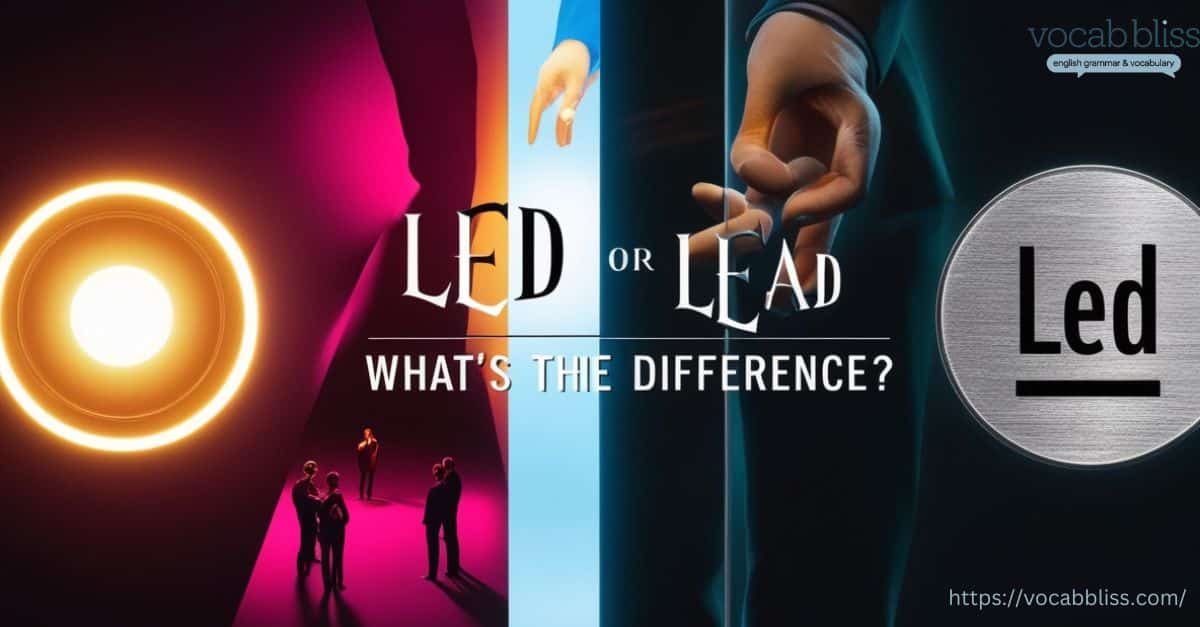
One of the most common confusions is between “lead or led.” Here’s a quick breakdown:
- Led: Past tense of the verb “lead.” Example: “She led the meeting yesterday.”
- Lead: Present tense or the metal. Example: “They lead the league in points,” or “The pipe contains lead.”
Pro Tip: Always double-check context and pronunciation to avoid mix-ups. Additionally, paying attention to these details can help ensure clarity in your communication..
Quick Quiz: Test Your Knowledge leed vs lead
Here’s a quick quiz to test your understanding of LEED or lead. See how much you’ve learned!
- What is the primary focus of LEED certification?
a) Building aesthetics
b) Energy efficiency and sustainability
c) Historical significance of buildings
d) Architecture style - Which of the following is NOT a meaning of the word “lead”?
a) A position of leadership
b) A heavy metal
c) A method for guiding others
d) A certification for green buildings - Which pronunciation of “lead” is used when referring to the metal?
a) Leed
b) Led
c) Both are correct
d) None of the above - Which of these would likely be LEED certified?
a) A new, energy-efficient office building
b) An old, historically preserved building
c) A building with outdated plumbing systems
d) A building that uses lead-based materials - Which is an example of using “lead” in a sentence?
a) “She will lead the team through the next challenge.”
b) “The contractor used lead pipes in the plumbing.”
c) “We need to track our sales leads.”
d) All of the above
Answer Key:
- b) Energy efficiency and sustainability
- d) A certification for green buildings
- b) Led
- a) A new, energy-efficient office building
- d) All of the above
Verbs Similar to “Lead”
There are many verbs that convey the meaning of “lead” in different contexts. Here are some synonyms with examples to clarify their usage:
- Guide: To show the way or direct someone or something.
- Example: “She will guide the group through the training session.”
- Direct: To manage or control the actions of others, especially in a formal capacity.
- Example: “The director will direct the team’s efforts in completing the project.”
- Manage: To oversee or control the work or actions of others.
- Example: “He manages a team of developers in the IT department.”
- Navigate: To steer or find the course through a path or process.
- Example: “The project manager will navigate the challenges of the construction phase.”
- Supervise: To oversee the work or activities of others.
- Example: “The supervisor will supervise the daily operations of the warehouse.”
- Control: To have command over actions or events.
- Example: “She controls the budget and allocates resources for the department.”
Each of these synonyms can, therefore, be used interchangeably with “lead,” depending on the specific context of the situation.
Practical Examples in Sentences
Here are some examples showing the use of “lead or LEED” in context:
Lead as a Metal:
- Example: “Lead is used in the construction of radiation shielding because of its density and ability to block harmful rays.”
- Example: “Old pipes made of lead were replaced to ensure the safety of the drinking water.”
Lead as a Verb:
- Example: “As a team leader, he will lead the project from concept to completion.”
- Example: “She plans to lead the marketing campaign for the new product launch.”
LEED in Sustainability:
- Example: “This building was awarded LEED certification for its green design, including solar panels and rainwater harvesting systems.”
- Example: Our new office meets the LEED Gold standard, which, as a result, reduces energy consumption by 30%.
LEED in Architectural Design:
- Example: The design incorporates sustainable materials and energy-efficient systems; as a result, it earned a LEED Silver rating.
- Example: “LEED-certified buildings use natural light, reduce waste, and promote overall well-being for occupants.”
A Final Look at Lead or LEED
Understanding “LEED or lead: When to Use Which One?” boils down to context:
- Use “lead” for leadership, sales opportunities, or the heavy metal.
- Use “LEED” for sustainable building and eco-conscious practices.
Being precise with these terms not only enhances your communication but also reflects your attention to detail. Whether you’re discussing business strategy or sustainable design, knowing the difference makes all the difference.
Expand Your Knowledge:
- Is It Fourty or Forty? Which One Is Accurate?
- Inbetween or In Between? Which Is Correct?
- Pick Up or Pickup, Pick-Up: How Should It Be Used?
- Infact or In Fact: What’s Grammatically Correct?

Jorge Phillips is an experienced blogger who writes for Vocab Bliss, sharing his passion for the English language. With a knack for simplifying complex grammar rules and a focus on commonly confused words, Jorge helps readers navigate the nuances of English with ease. His insights aim to make learning engaging and practical.
